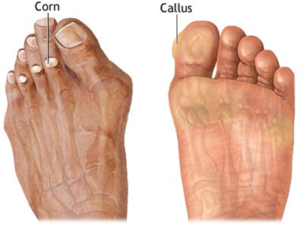The human body is amazing in its ability to protect itself from repeated pressure and sheering (frictional) forces. It is this adaptive tendency that creates corns and calluses on the feet.
Corns and calluses are thick layers of skin that develop when your skin tries to protect itself against friction and pressure forces. They most often develop on the bottom of the feet and toes. Corns and calluses can be unsightly, and may be very painful. They may create pressure sores on the bottom of your feet that can turn into ulcers. In some instances, soft corns may develop between the toes, and can cause extreme discomfort.

If you have diabetes or another condition that reduces blood flow to your feet, you’re at greater risk of complications from corns and calluses such as ulceration and infection.
Cause
Corns and calluses are not the same. Corns usually develop in areas of increased pressure, while calluses develop in areas of increased friction.
Use of ill-fitting footwear, such as high heels and narrow shoes, skipping socks or having poor foot biomechanics may make you more prone to developing corns and calluses. All of these factors increase the amount of pressure and friction forces applied to your feet.
Symptoms
You may have a corn or callus if you notice:
- A thick and rough area of skin on your feet
- A hardened, raised bump on your feet
- Tenderness or pain underneath your skin
- A flaky, dry or waxy skin appearance
Treatment
Treatment for corns and calluses involves avoiding the repetitive actions that initially caused them to develop, and use of proper foot emollients. By eliminating the source of friction or pressure, the lesions usually disappear.
Most people who have corns and/or calluses resolve them by:
- Trimming away excess skin: Your Chiropodist or Podiatrist (Foot Specialists) may pare down the lesion and remove the corn using a scalpel. Do not attempt this yourself as it can lead to infection.
- Callus-removing medication: You may be prescribed a keratolytic compound to aid in the removal of the lesion.
- Emollients: A foot cream containing at least 10% urea may be recommended to prevent recurrence of the lesions.
- Custom Foot Orthotics: Help correct foot biomechanics to reduce friction forces and redistribute pressure forces upon the feet.
- Change of footwear: Stick to well-fitting shoes and socks, which eliminate unnecessary pressure forces that may have caused the lesions to develop.
- Surgery: In rare instances, your Chiropodist may recommend bony reconstructive surgery to realign and reduce internal forces.
Contact us today to see how we can alleviate foot pain caused by corns & calluses.

